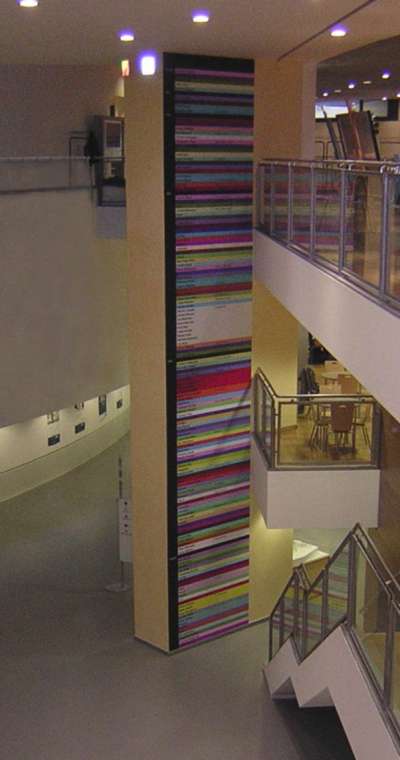The Audition in Colour: imagining otherness and finding new forms of expression
Have you ever thought that your face was a work of art? Curator and art writer Chiedza Mhondoro explores Sonia Boyce's The Audition in Colour.

Sonia Boyce, The Audition in Colour, 1997/2020 © Sonia Boyce. All rights reserved, DACS 2022. Purchased from Goodman Gallery, with funds raised from print sales from the Robson Orr TenTen Award, a GAC/Outset Annual Commission.
‘Have you ever thought that your face was a work of art?’ asked visual artist and academic Sonia Boyce in a publicity brochure for Cornerhouse (now called HOME), a contemporary visual arts centre in Manchester. Boyce, who is currently representing Britain at the Venice Biennale, was inviting members of the general public to don a short synthetic Afro wig and be photographed with and without it. In the months of October and November 1997, 30,000 copies of the brochure were distributed in Manchester and further afield. Over fifty people accepted the invitation and Boyce took 900 photographs.
The Audition in Colour comprises a selection of the colour images shot that one day in 1997. They are double portraits of individuals that fill the whole frame and are installed alongside nameplates. In the headshot on the left, the sitter wears the Afro wig and in the other their natural hair. The 75 prints together at almost two metres long are arresting wherever they hang.
The response to Boyce’s brochure advert was dependent on the appeal of participating in an unusual event, wearing a wig to play with the expression of identity and performing a role inspired by this wig. Wigs have been worn globally for centuries. Ancient Egyptian royals expressed nobility through wigs styled in braids and adorned with ivory and gold ornaments. Queen Elizabeth I was committed to hers throughout her life and lawyers across various legal jurisdictions in the UK have worn wigs since the seventeenth century. Numerous celebrities including John Travolta, Keira Knightley and Laverne Cox have worn them for a variety of reasons.
In Black communities, wigs and an assortment of other styles including braids, cornrows, dreadlocks, silk presses and weaves are worn not only to protect hair from the stresses of harsh weather and over-manipulation, but to continue the centuries-long tradition of self-expression and creativity. No other hair type, however, has as many assumptions attached to the wearer, nor has been as historically politicised. Boyce’s invitation in 1997 withheld her racialisation as Black as she believed not many people would attend what could be misunderstood as a political event. The Audition in Colour brought to the fore a number of complex issues surrounding representation and a fascination with the ‘other.’
Boyce’s earlier work, Do You Want To Touch?, humorously explored this fascination. The installation of thirty hair pieces gathered from afro-caribbean hair shops responded to the often unwelcome touching of a Black person’s hair, or asking to do so, which conjures up feelings of being exoticised and othered in the recipient of the attention. Do You Want To Touch? playfully and provocatively offered the opportunity to satiate the desire in some to touch Black hair. Part of the appeal of this hair is its textures. Another is its versatility which allows the wearer to alter their appearance in a way akin to shapeshifting. The multiple options for self-expression offered by afro-textured hair are freeing.
Fast forward a quarter of a century and Boyce reprises the notion of freedom, especially in Black women. Representing Britain at the Venice Biennale as the first woman Black woman to do so, her installation Feeling Her Way (2022) features the videos of five Black* female musicians who improvise and play with their voices. The British Council which commissioned the work described the sounds of the rooms of the British pavilion as embodiments of “freedom, power and vulnerability.” When accepting the Golden Lion for best national pavilion, one of the two highest awards at the Biennale, Boyce stated to ArtNet that the performances arose from the question, “As a woman, as a Black person, what does freedom feel like? How can you imagine freedom?”
Boyce conveyed this freedom in the British pavilion by amplifying the voices of the Black women who are often sidelined. Feeling Her Way expanded upon the Devotional project which Boyce started in 1999 to excavate the often hidden and forgotten history of Black female musicians and singers. She conducted conversations with members of the general public about their favourite Black female singers. In the first session, it took ten minutes for the participants to name anyone. Boyce then listed them from one to eighty-four by name and date in a totem-like list on aluminium-mounted laminated paper. The Government Art Collection acquired the work in 2004 and in its current location in Whitehall’s Foreign, Commonwealth & Development Office, it rises over two metres. In 2005, the Government Art Collection commissioned Boyce to produce a second version of Devotional II for the European Union Headquarters in Brussels, where it remains on display today.
This year’s Venice Biennale and the Government Art Collection’s placement of Boyce’s work in domestic and international government buildings promotes a visual representation of Britain that incorporates facets of Black culture into it. As the largest and most dispersed public collection of British art in the world, it attests to the varied expressions of identity and creativity in these isles. The presentation of the collection, often in impressive stately buildings, somewhat mirrors Boyce’s artistic practice. Both represent identity in performative ways towards an audience and draw attention to the finding of new forms of expression.
*here Black is adopted as an umbrella term for the collective voice amongst people of African, South Asian and Caribbean descent who share experiences of discrimination and racialisation in the UK. This term gained traction in the 1980s.


